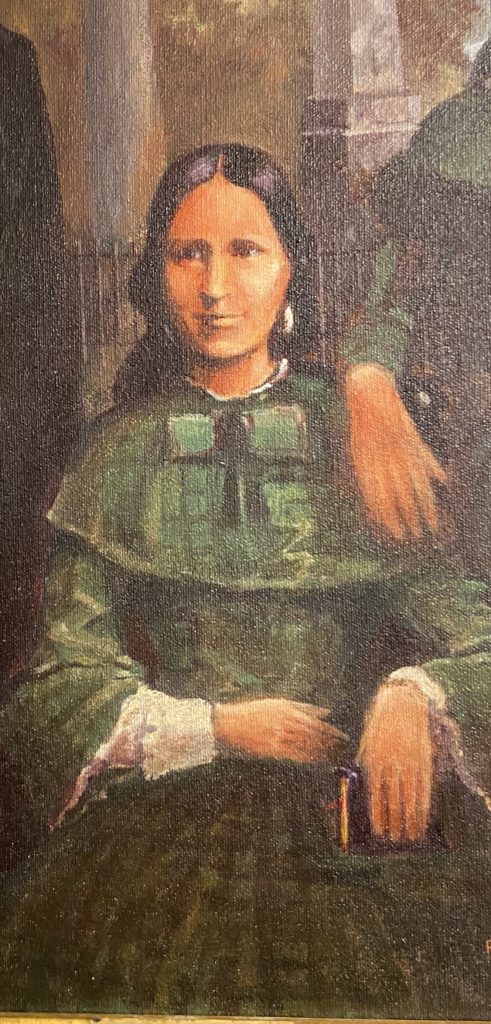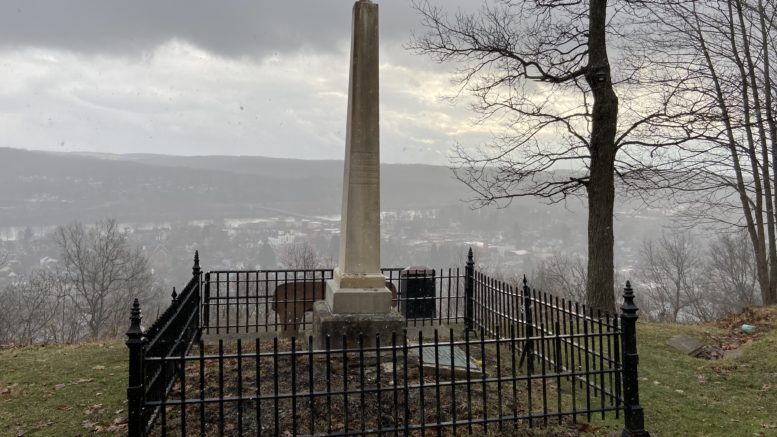Several months ago, Owego Mayor Mike Baratta asked me to do some research on the Sa Sa Na Loft monument, which stands in Evergreen Cemetery in the Village of Owego, N.Y. As the story goes, the Mayor had corresponded with a gentleman from the area who had been inquiring to local officials as to the notion that the Sa Sa Na monument may be the oldest monument to a Native American in the United States.
Commissioned and intrigued, I began my research at the local level. I asked around to my fellow historians here in Tioga County, of which we are fortunate to have several excellent ones of both public and private status. I was certainly surprised to find out that the notion that the Loft monument could be the first monument to a Native American or even the first monument to a Native American woman had apparently, at least in recent history, never been broached.
Somewhat baffled at this finding, I moved forward with some basic Meta Internet searches. After a few of hours of searching for Native American databases and the like, hoping to score a website that would contain all the information I needed, I came up empty.

My next attempt at researching the Loft monument would be to optimistically contact historians at the state and national levels. My letters to them contained my subject, purpose, and appeals for any information regarding Native American monuments. In addition, if the Loft monument’s unique status could be confirmed, I naively hoped that the state or national government could provide to the Village of Owego some validation or certification of such.
Over several weeks my correspondence included talking to and or emailing the following experts, with one referring me to the next. At the Division of New York State Historic Preservation, I contacted a ‘Program Analyst,’ then a ‘Scientist / Archaeologist,’ then the New York State ‘Ethnologist,’ and the ‘New York State Historian.’
At our National level, I contacted a National Parks Service ‘Staff Historian’ and the ‘Chief Historian’ of the National Parks Service. In addition, and upon another referral, I corresponded with a well-known Mohawk Nation historian and author.
In amalgamating the responses from the experts, I would say that they were enthusiastic about the topic, encouraging, and interested in my quest. But they were unable to offer any compilations of data or research shortcuts for me. With all due respect to them, they more or less told me to ‘knock myself out.’
The next phase of my research would include finding the names of any well-known Native American warrior, VIP, and or person of interest, or notoriety. Then I examined only those Native Americans whose life and times pre date the Sa Sa Na Loft monument date of 1855. After many hours spread over several weeks, I was yet to find any monument to pre date Sa Sa Na’s. The closest I had found was Seneca Chief Cornplanter / John Abeel’s monument from 1866, which in 1965, due to the building of the Kinzua Dam, had been relocated to the Riverview-Corydon Cemetery in Elk Township, Warren County, Pa. and near Salamanca, N.Y.
Although things were looking good for Sa Sa Na’s potential new acclaim, I was struggling to define what qualifies as a ‘monument’ and delineate the differences between various tributes such as monuments, memorials, busts-and other works of art, plaques on stones, elaborate headstones and the like. What should count as the first or earliest monument?
For example, the great Wampanoag leader Metacom, among many tributes, had a sketch drawn of him in 1820 and had a textile mill in Fall River Massachusetts named after him in 1847 that seems like a monumental recognition. In another case, in 1772 Tammany the Lenni-Lenape Chief had the first of many ‘societies’ named after him. In 1794 even a Broadway opera was named after him, and a wooden sculpture was made of him in 1817 that in 1869 would end up bronzed and in the U.S. Naval Academy. (Smithsonian American Art Museum. “Tamanend, Chief of Delaware Indians (1628-1698).
I found that many famous Native Americans such as Tecumseh, Hiawatha, Sequoyah, Osceola, and Sa Sa Na’s Mohawk relative, Thayendanegea / Joseph Brant, all have multiple namesakes, and tributes made in their honor, but none before Sa Sa Na. Another interesting find was Saint Kateri Tekakwitha, the Algonquin / Mohawk, who died in 1680. Among several tributes to her she has no less than four national shrines in the United States and a shrine in Canada, but none that I could find dated before the 19th century except a portrait of her from the 17th century, located at www.kateritekakwitha.org. Surprisingly, some of the most well known Native Americans such as Squanto, Pocahontas, and Sacagawea have few or much more recent tributes made to them, not to mention a myriad of famously known Native Americans whose life and times post date Sa Sa Na.
Unexpectedly and unfortunately, I came upon Cayuga Chief Logan the Orator’s monument. Finished in 1852 for the new Fort Hill Cemetery in Auburn, N.Y. The massive 65 foot tall stone obelisk monument is an impressive site that pays tribute to this great Native American leader who in c. 1723 was born in the Auburn area. Logan is not interred there however but his monument predates Sa Sa Na’s by three years. Thus, the Logan monument is likely to be the earliest monument overall in the United States.
According to my research, the inclusion of the Logan monument drops Sa Sa Na’s monument into the number two position on the overall list of earliest monuments to Native Americans, while maintaining the title of earliest known monument with interment. However, I am proud to, in good faith, announce that Sa Sa Na’s monument is clearly holding the top position of the earliest monument to a Native American women in New York, the United States of America, and maybe all of the Americas. So the answer to the question that I posed in the title of this article is YES!
In lieu of any official guidance, I believe that a monument, tribute, and a memorial can be one in the same. The physical monument itself is usually extraordinary as well as the life of the person or persons that the monument is representing. In addition, the advent of the monument’s placement should be one of ceremony, public interest and public accessibility. I had asked, if proven, for an official blessing from the government’s history experts for Owego to use the moniker: ‘Sa Sa Na Loft-Earliest Monument to a Native American Woman in the United States.’ But with murky definitions of what a monument is and no collective data regarding monuments, I don’t believe that can happen, and I can understand that.
With all this in mind, my hope is to recognize Sa Sa Na Loft, and our monument to her wonderful life with a ceremonially placed historic marker at her now amazingly historic gravesite in Evergreen Cemetery. If approval by the Village of Owego Board of Trustees is granted, the historic marker could read, “SA SA NA LOFT: MOHAWK MAIDEN, CHRISTIAN MUSIC MISSIONARY, EDUCATIONAL PATRON OF THE MOHAWKS. SHE DIED IN A TRAGIC TRAIN ACCIDENT IN 1852. THIS OBELISK ERECTED BY OWEGANS IN 1855 IS THE EARLIEST KNOWN MONUMENT TO A NATIVE AMERICAN WOMAN IN THE U.S.A.”
If anyone has any relevant data regarding Native American monuments, email to stephenbeukema@gmail.com.



thank you, Stephen Beukema for this exhaustive and excellent research and tribute… good on to historians and scholars
Well done.
Thank you for your exhaustive work in finding more information on SaSaNa(Suzanne)Loft and other indigenous leaders she was my great grandfathers aunt
Nia:wen/ Thank you Stephen,
Well done article makes me so proud.
My name is Kahsennenhawe Loft- Mohawk with family from Canada Tyendenega, Ontario. Cousin to Joseph Brant and Sasana. My great great grandfather was a traveling singer too. This story makes me happy that Native women are being honored, this one more step to Reconciliation….. 🙂